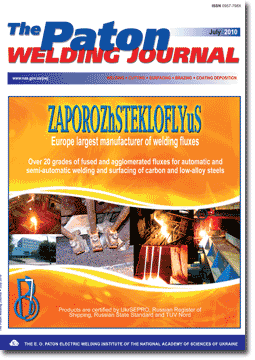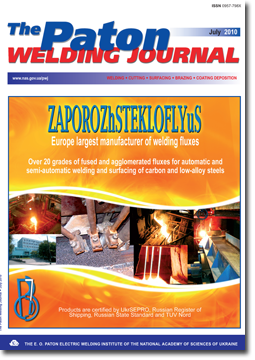| 2010 №07 (09) | 2010 №07 (01) |

TPWJ, 2010, #7, 41-43 pages
CLEANING AND ACTIVATION OF WELDED SURFACES DURING EXPLOSION WELDING
Journal The Paton Welding Journal
Publisher International Association «Welding»
ISSN 0957-798X (print)
Issue № 7, 2010 (July)
Pages 41-43
Authors
L.B. PERVUKHIN1, O.L. PERVUKHINA1 and S.Yu. BONDARENKO2
1Institute of Structural Macrokinetics and Materials Science, RAS, Chernogolovka, RF
2Altai State Agrarian University, Barnaul, RF
Abstract
Absence of the cumulative effect in explosion welding of large-sized samples and commercial size plates in the modes used in commercial production is experimentally proved. The mechanism of cleaning and activation of surfaces ahead of the contact point is proposed, based on the hypothesis of formation of thin layers of low-temperature plasma in the welding gap on the interface between the shock-compressed gas and surfaces being welded. It is suggested than formation of strong bonds between atoms of the joined metals in explosion welding should be regarded as a three-stage process.
Keywords: explosion welding, welded surface, oxides and contamination, cleaning, activation, cumulative jet, plasma flows, contact point, three-stage process
Received: ??.??.??
Published: 28.07.10
References
1. Gelman, A.S., Chudnovsky, A.D., Tsemakhovich, B.D. et al. (1978) Explosion cladding of steel. Moscow: Mashinostroenie.
2. Deribas, A.A., Zakharenko, I.D. (1975) On surface effects at oblique collisions of metal plates. Fizika Goreniya I Vzryva, 11(1), 151-153.
3. Wittman, R.H. (1973) The influence of collision parameters on the strength and microstructure of an explosion welding aluminium alloy. In: Proc. of 2nd Int. Conf. on Use of Explosive Energy in Manufacturing Metallic Materials of New Properties (Marianske Lazne, CSSR, 1973), 153-158.
4. Deribas, A.A. (1980) Physics of explosion strengthening and welding. Novosibirsk: Nauka.
5. Otto, G. (1964) Aspect relating to the central institute for industrial research. In: NATO Proc. (Oslo, Norway, 1964), 1435-1441.
6. Babul, W. (1968) Niektore problemy laczenia wybuchowego. Warszawa: IMP.
7. Lysak, V.I., Kuzmin, S.V. (2005) Explosion welding. Moscow: Mashinostroenie.
8. Pervukhina, O.L., Berdychenko, A.A., Pervukhin, L.B. et al. (2006) Influence of atmosphere composition on formation of bonding between titanium and steel in explosion welding. In: Transact. on Explosion Welding and Properties of Welded Joints. Volgograd: VolgGTU.
9. Pervukhina, O.L., Pervukhin, L.B., Berdychenko, A.A. et al. (2009) Features of explosion welding of titanium to steel in a shielding atmosphere. The Paton Welding J., 11, 18-22.
10. Konon, Yu.A., Pervukhin, L.B., Chudnovsky, A.D. (1987) Explosion welding. Ed. by V.M. Kudinov. Moscow: Mashinostroenie.
11. Baum, A.F., Orlenko, P.P., Stanyukovich, K.P. et al. (1975) Explosion physics. Moscow: Nauka.
12. Ishutkin, S.N., Kirko, V.I., Simonov, V.A. (1980) Investigation of heat effect of shock-compressed gas on the surface of collision plates. Fizika Goreniya i Vzryva, 6, 69-73.
13. Bondarenko, S.Yu., Pervukhina O.L., Rikhter, D.V. et al. (2009) Determination of the parameters of shock-compressed gas in the welding gap ahead of the contact point in explosion cladding. The Paton Welding J., 11, 39-41.
14. Senokosov, E.S., Senokosov, A.E. (2005) Plasma arc surface cleaning of metallic parts. Metallurg, 4, 44-47.
15. Ashaev, V.K., Doronin, G.S., Ermolovich, E.I. et al. (2006) Application of methods of explosion welding and heat treatment of metals in production of multilayer armor compositions with higher bullet-proofness and viability. In: Transact. on Armament, Automation, Control. Kovrov.
16. Gelman, A.S., Pervukhin, L.B., Tsemakhovich, B.D. (1974) Study of some problems of surface cleaning in explosion welding process. Fizika Goreniya i Vzryva, 2, 284-288.
The cost of subscription/purchase order journals or individual articles
| Journal/Currency | Annual Set | 1 issue printed |
1 issue |
one article |
| TPWJ/USD | 384 $ | 32 $ | 26 $ | 13 $ |
| TPWJ/EUR | 348 € | 29 € | 24 € | 12 € |
| TPWJ/UAH | 7200 UAH | 600 UAH | 600 UAH | 280 UAH |
| AS/UAH | 1800 UAH | 300 UAH | 300 UAH | 150 UAH |
| AS/USD | 192 $ | 32 $ | 26 $ | 13 $ |
| AS/EUR | 180 € | 30 € | 25 € | 12 € |
| SEM/UAH | 1200 UAH | 300 UAH | 300 UAH | 150 UAH |
| SEM/USD | 128 $ | 32 $ | 26 $ | 13 $ |
| SEM/EUR | 120 € | 30 € | 25 € | 12 € |
| TDNK/UAH | 1200 UAH | 300 UAH | 300 UAH | 150 UAH |
| TDNK/USD | 128 $ | 32 $ | 26 $ | 13 $ |
| TDNK/EUR | 120 € | 30 € | 25 € | 15 € |
AS = «Automatic Welding» - 6 issues per year;
TPWJ = «PATON WELDING JOURNAL» - 12 issues per year;
SEM = «Electrometallurgy Today» - 4 issues per year;
TDNK = «Technical Diagnostics and Non-Destructive Testing» - 4 issues per year.


